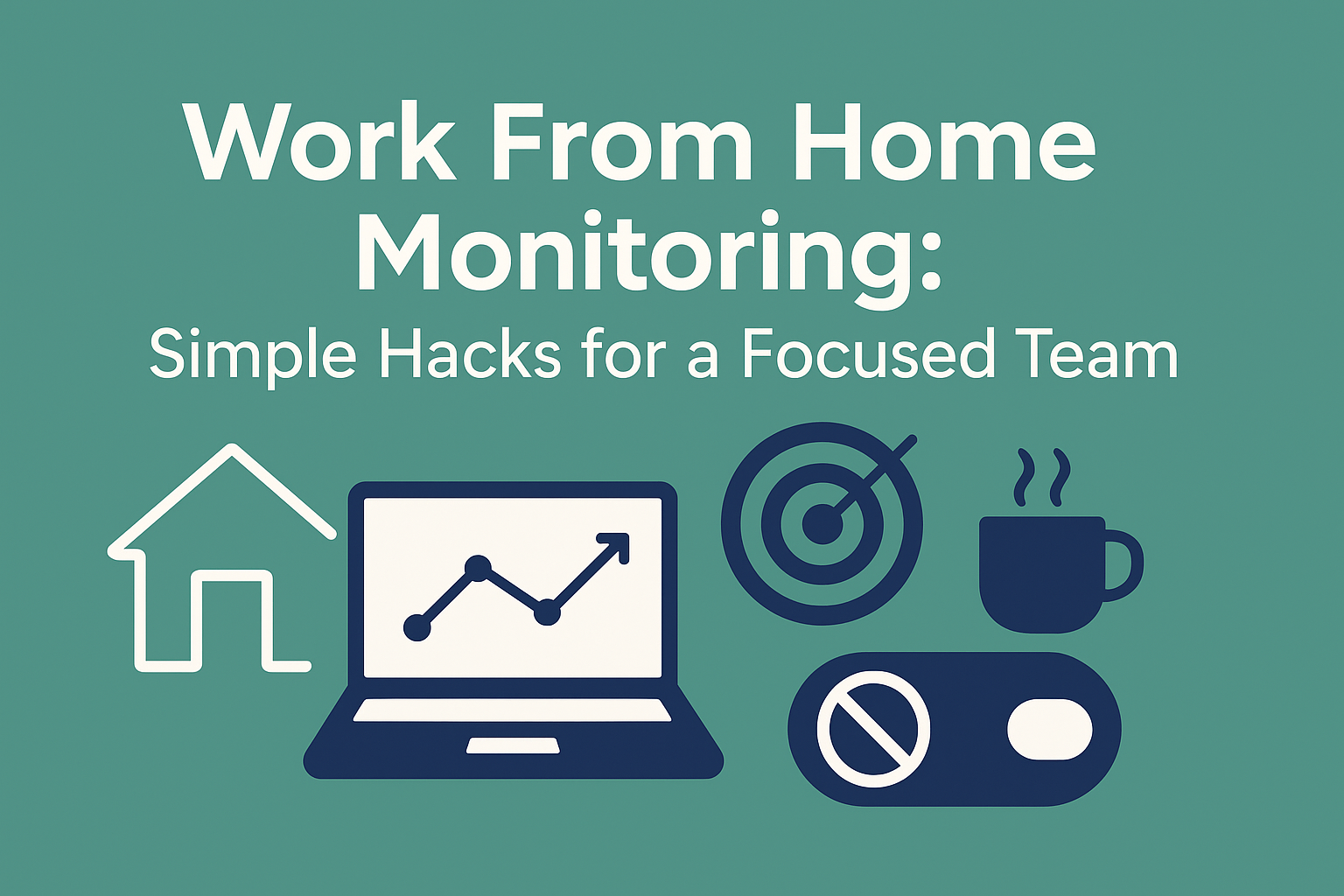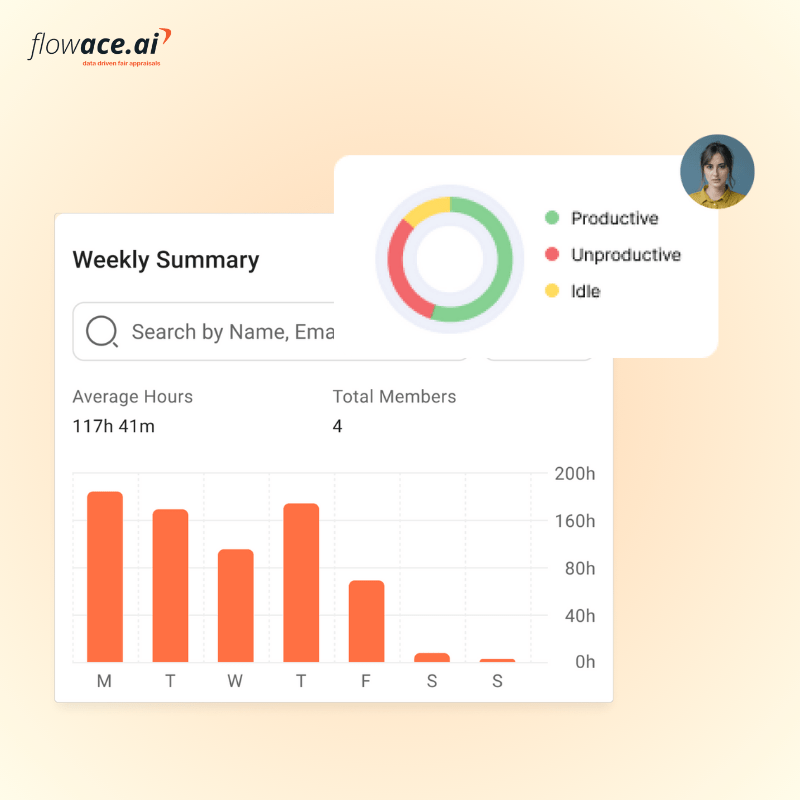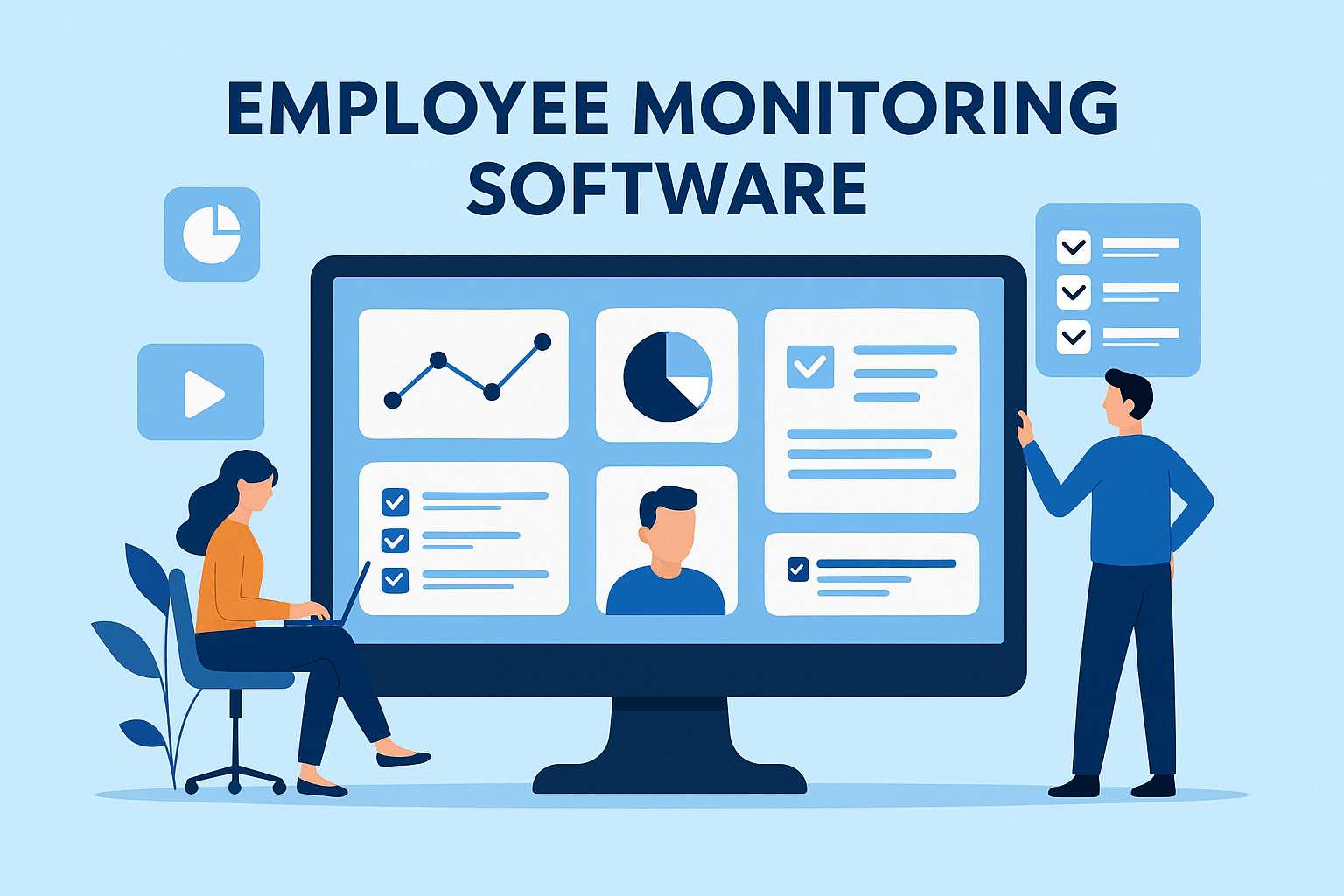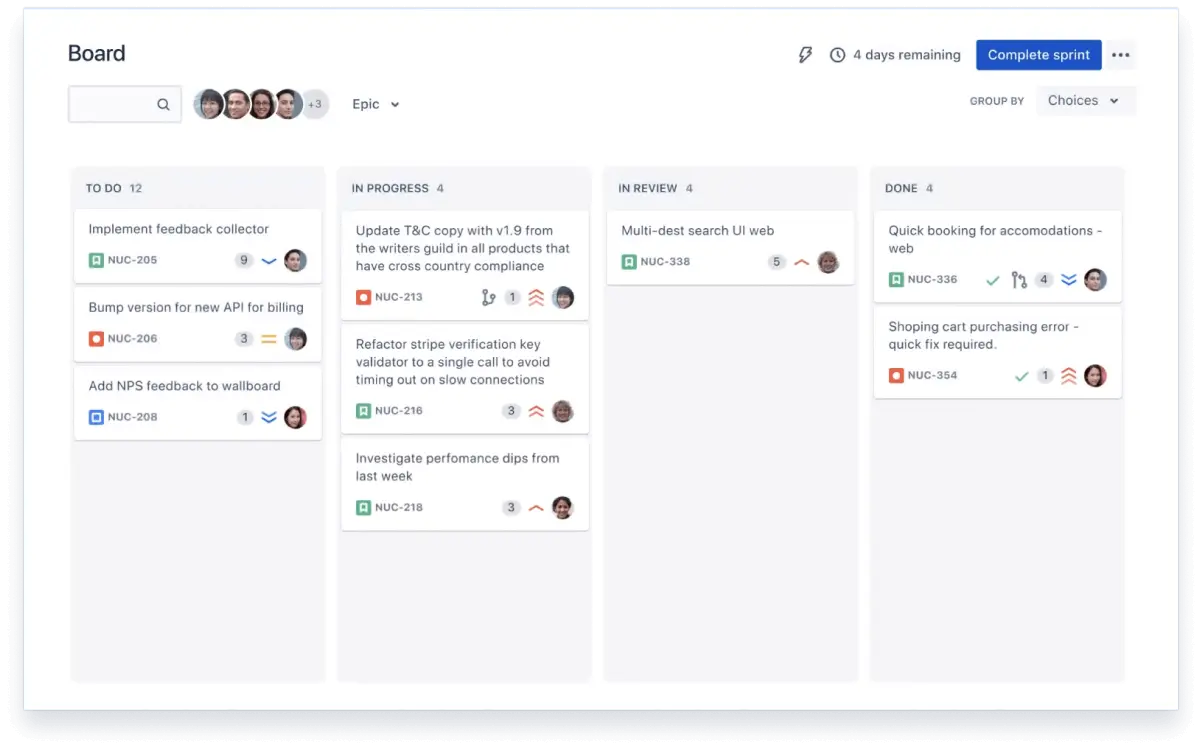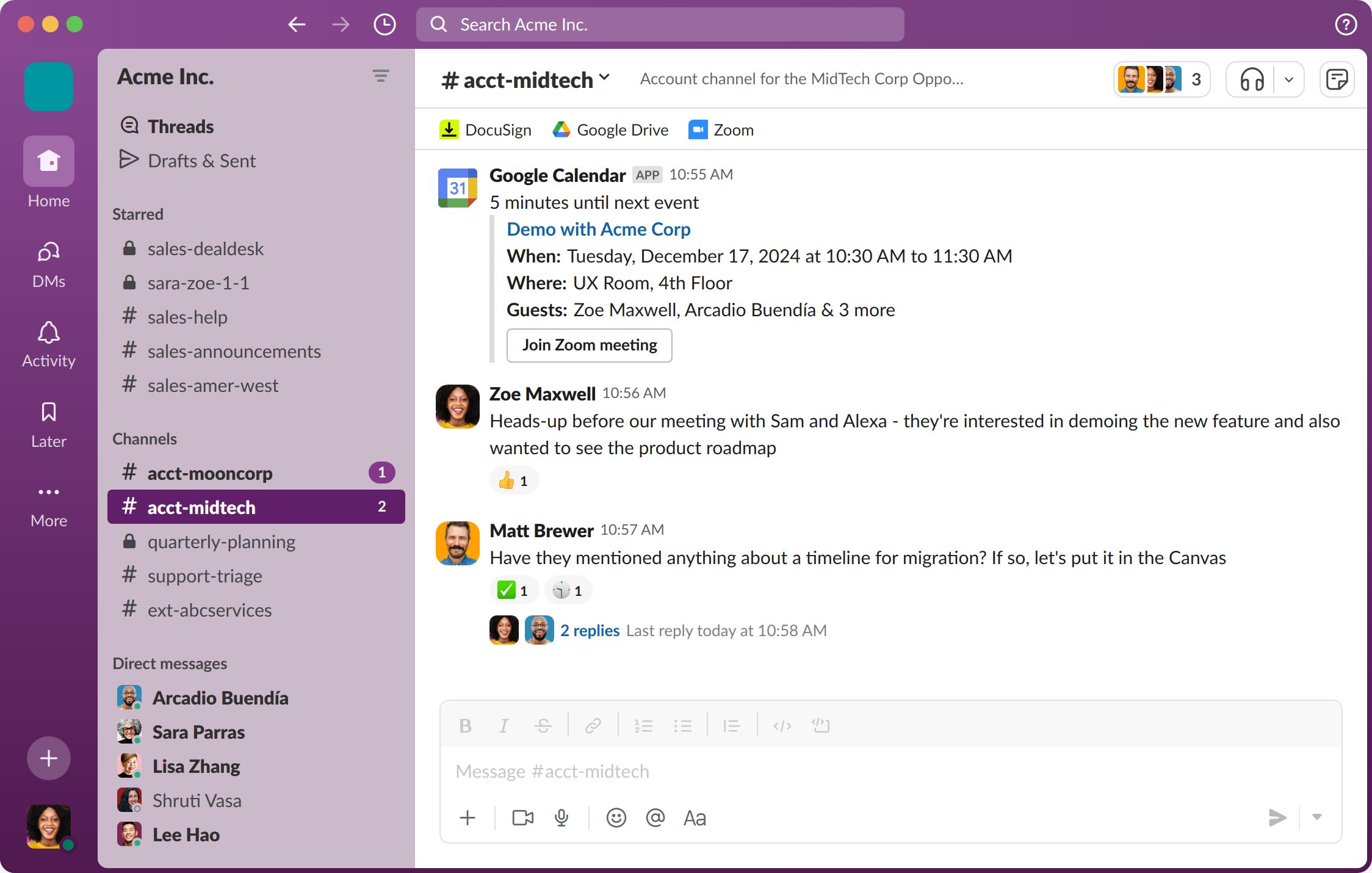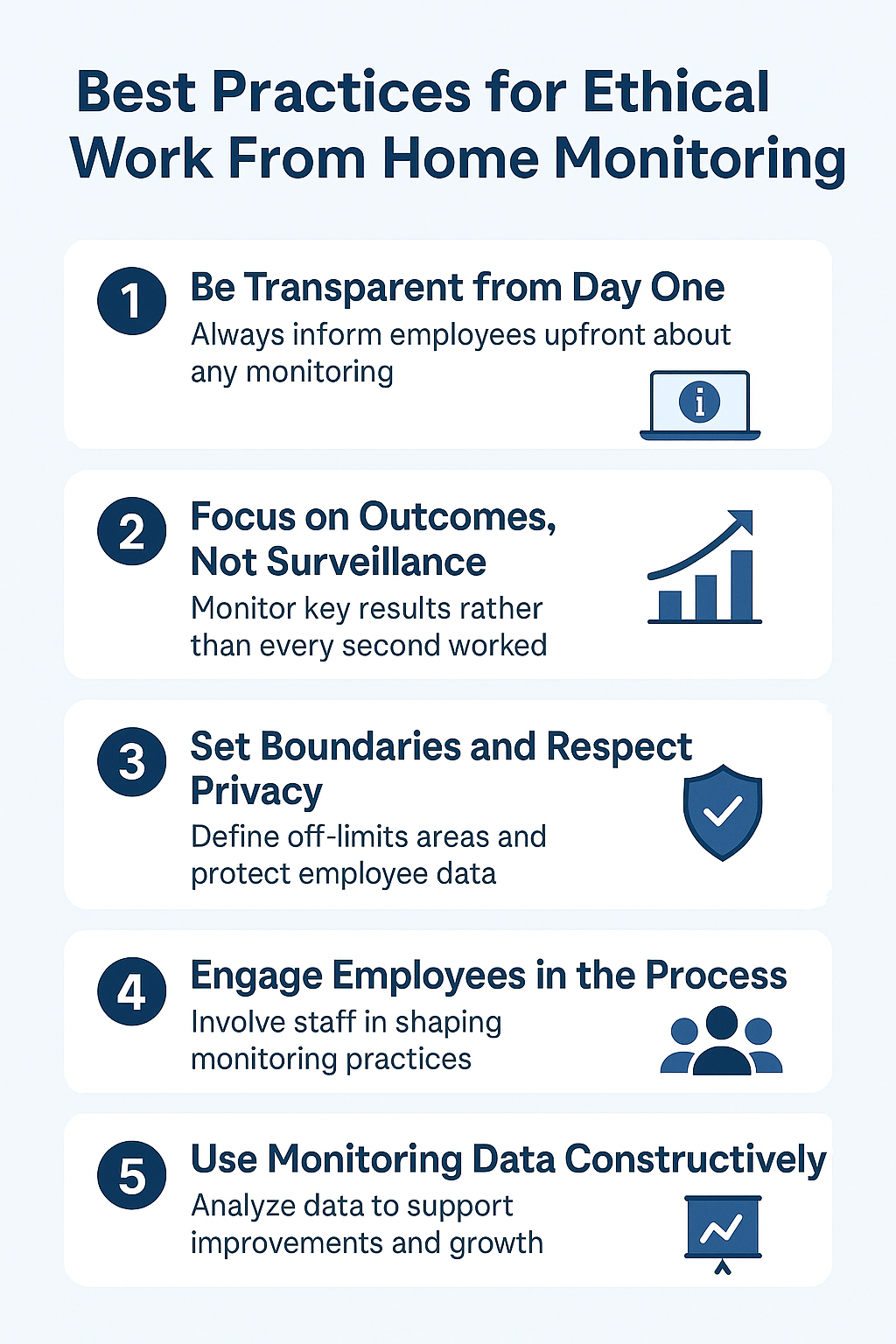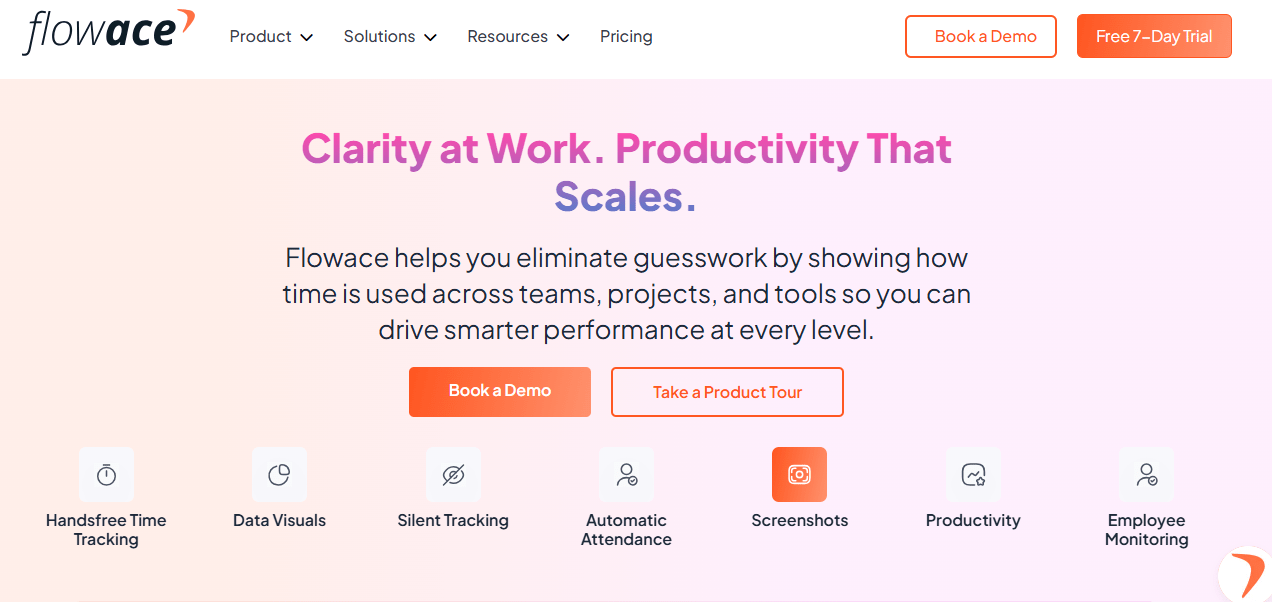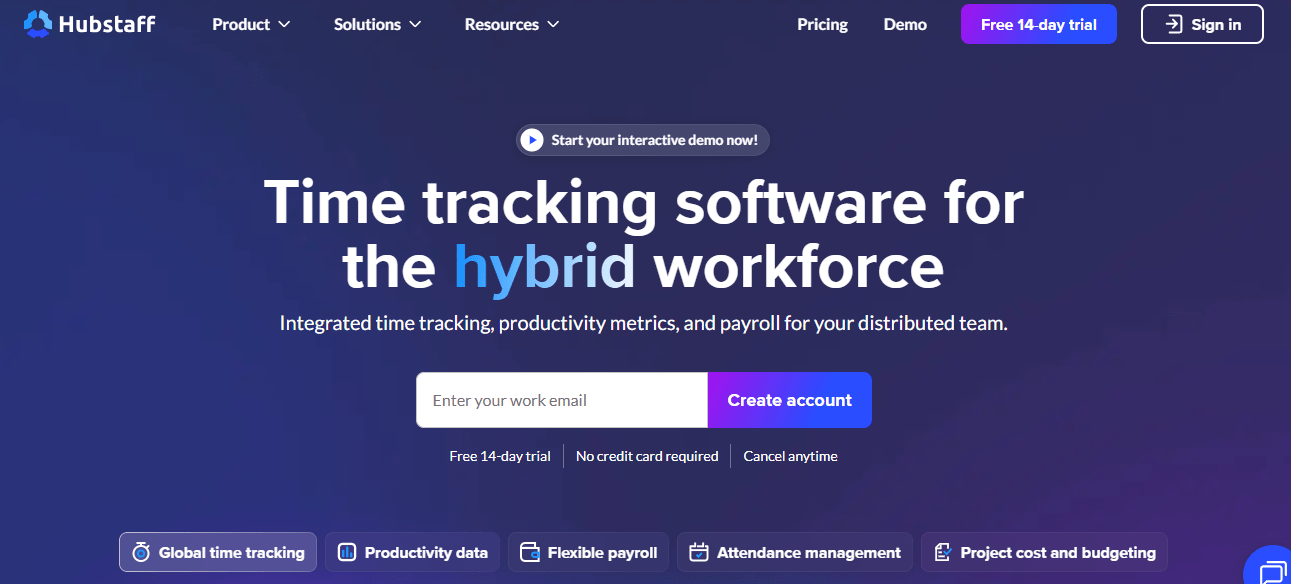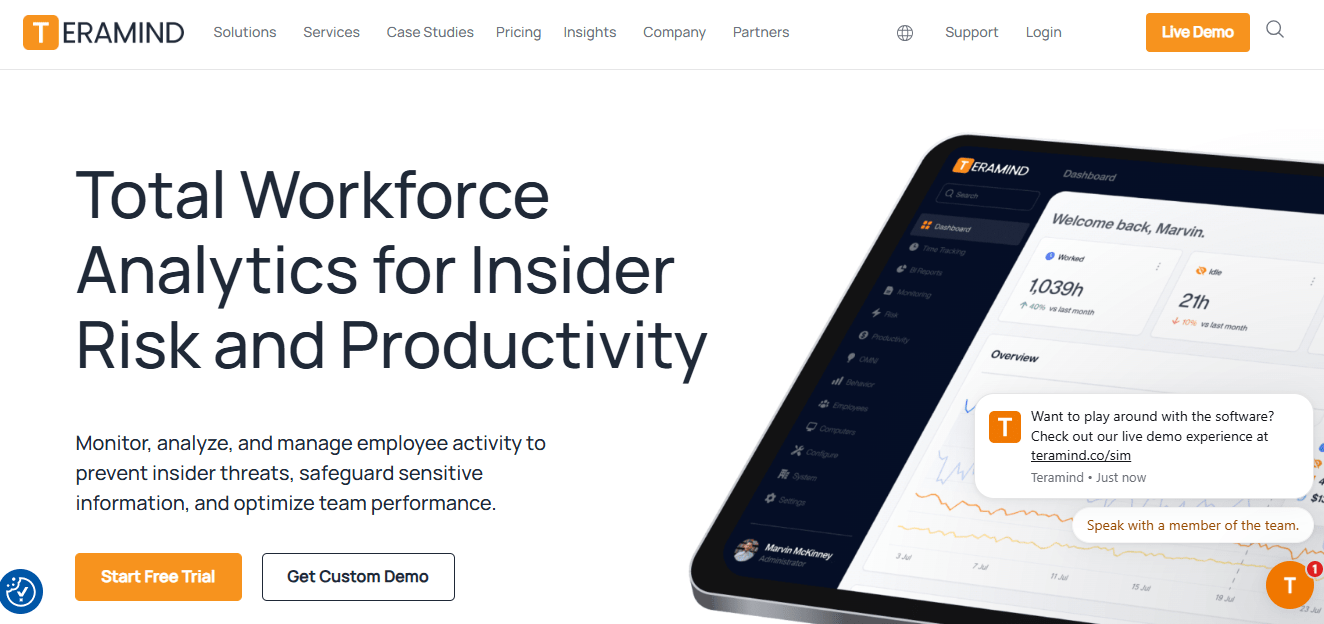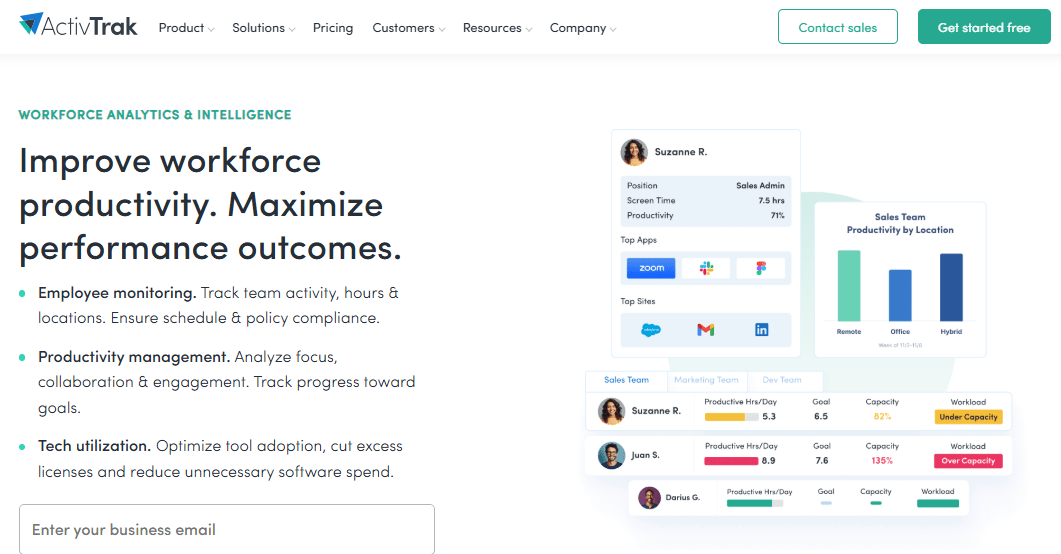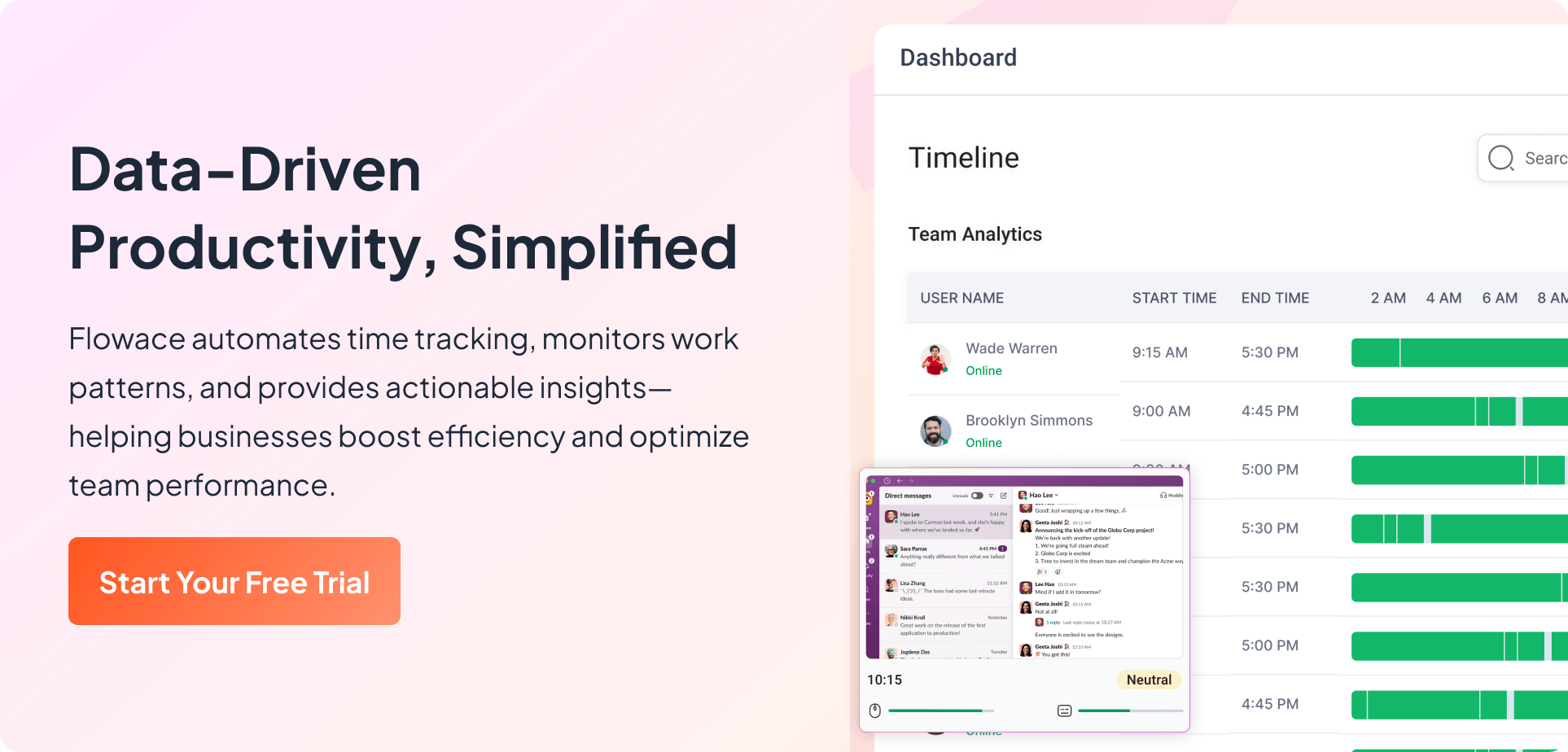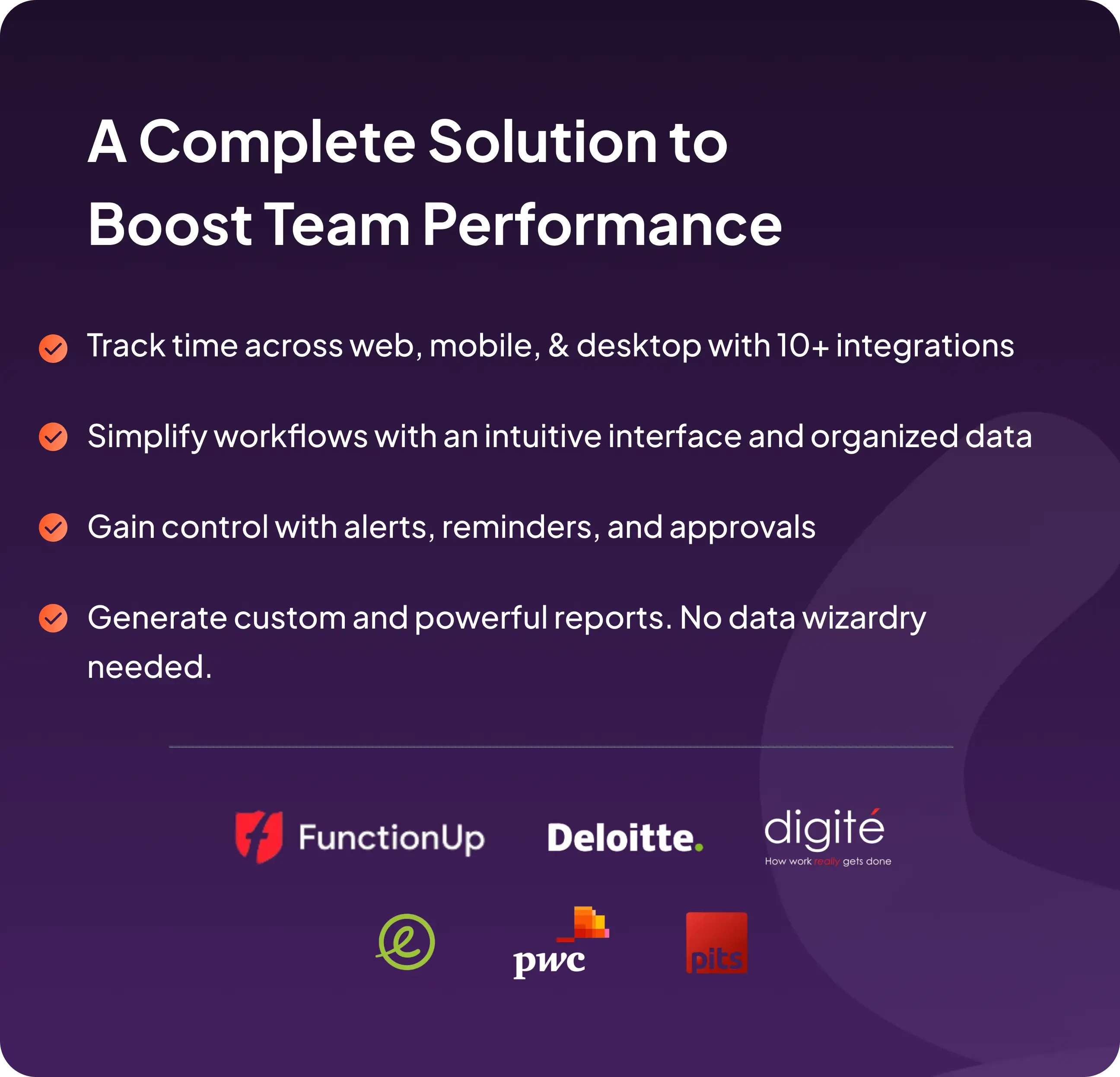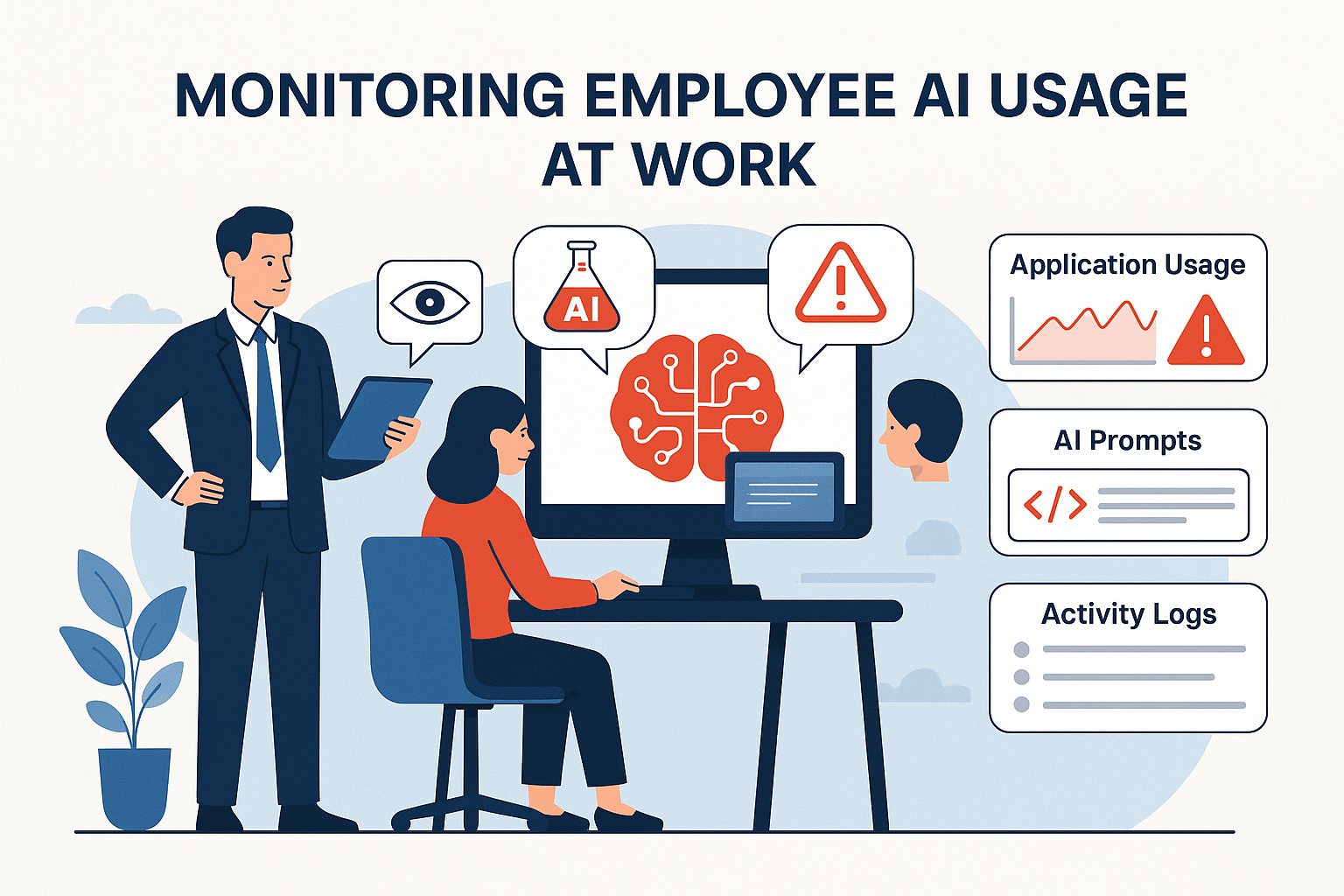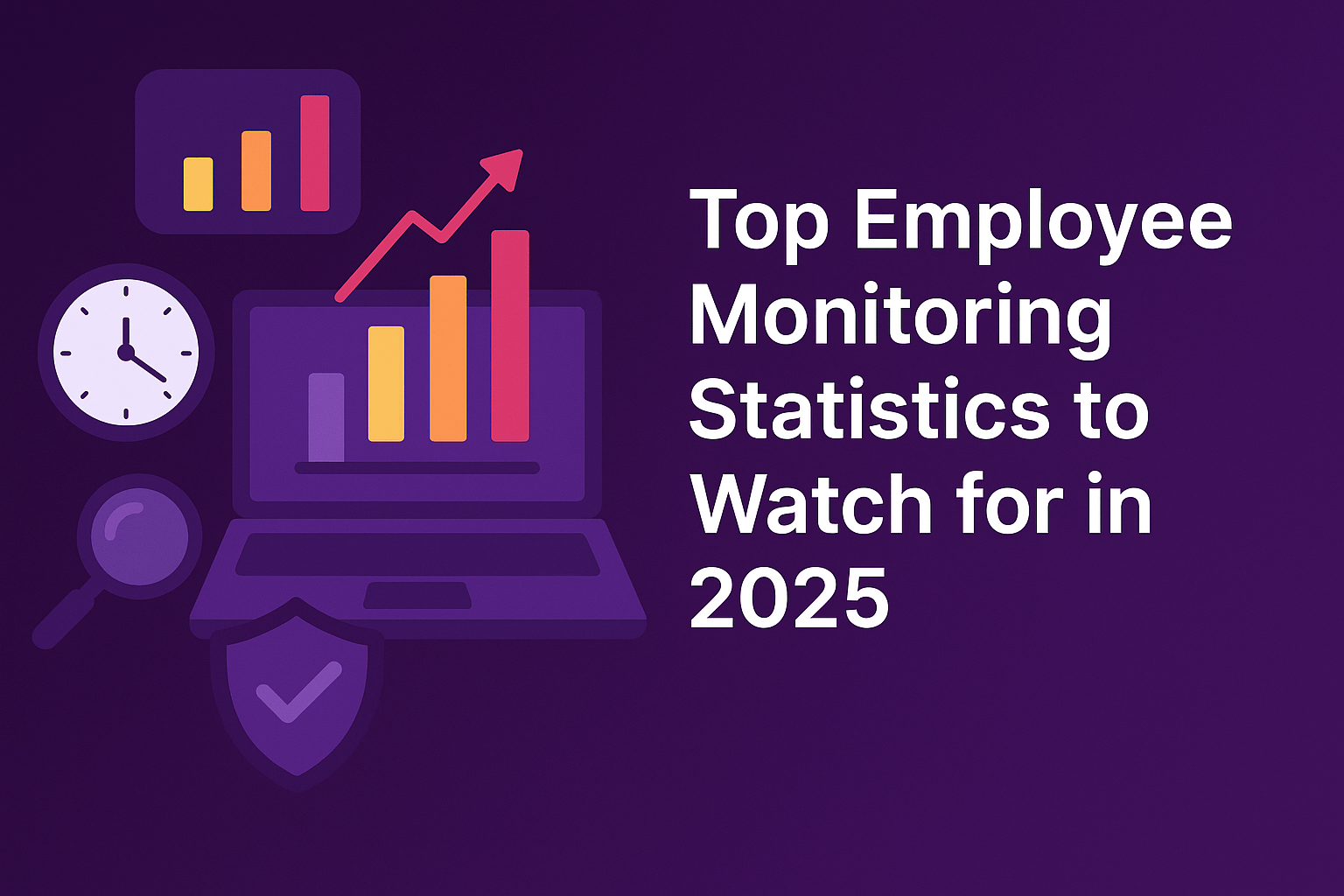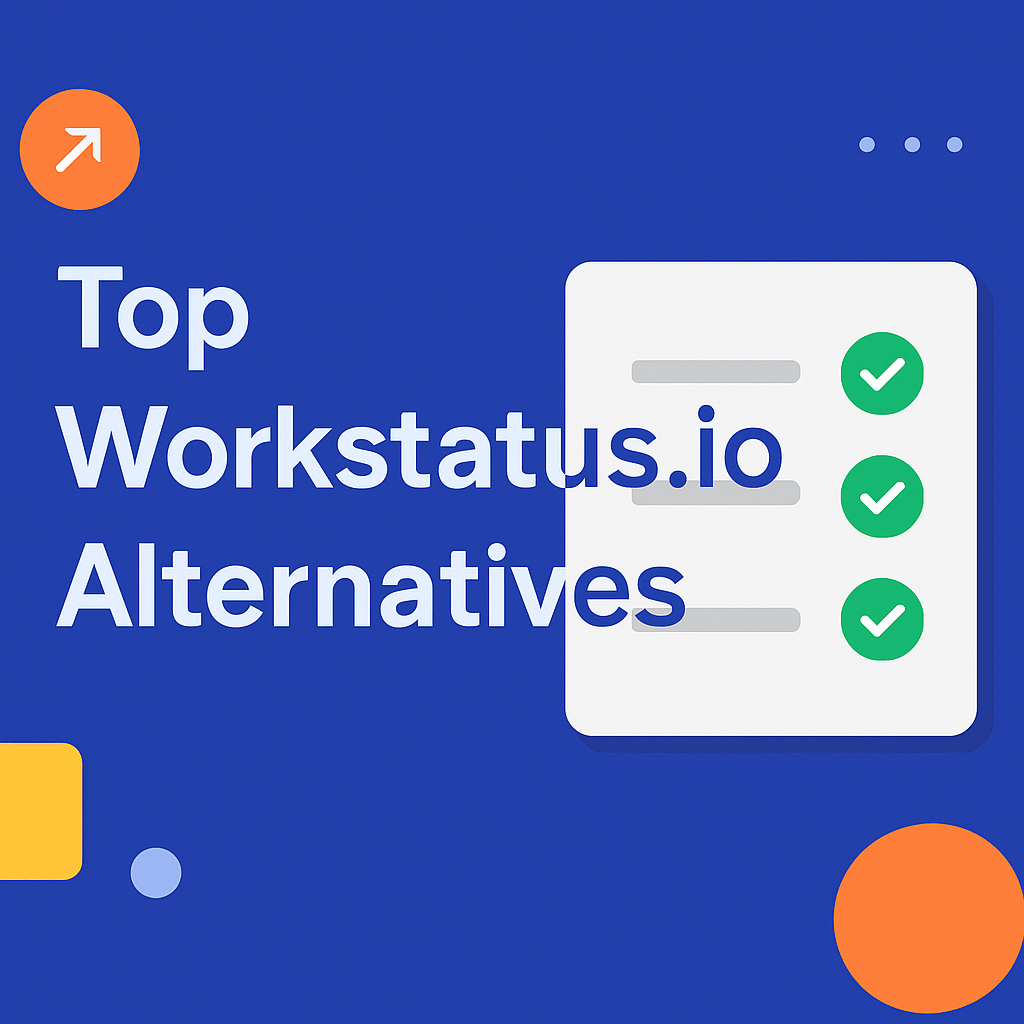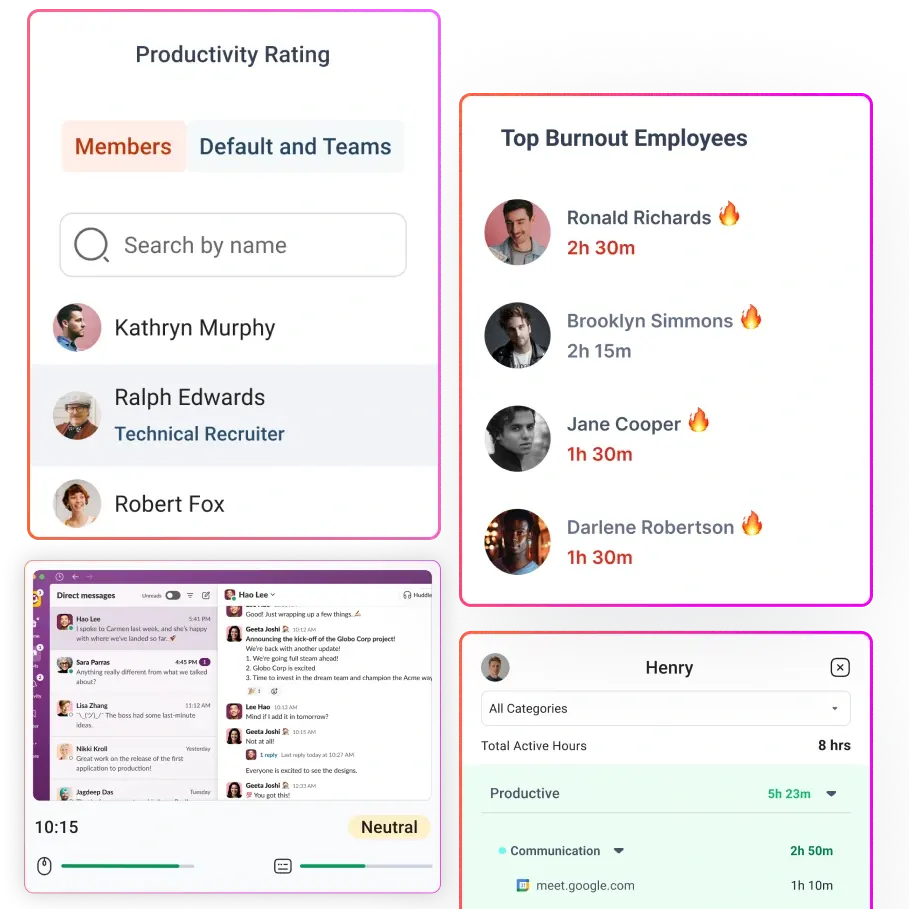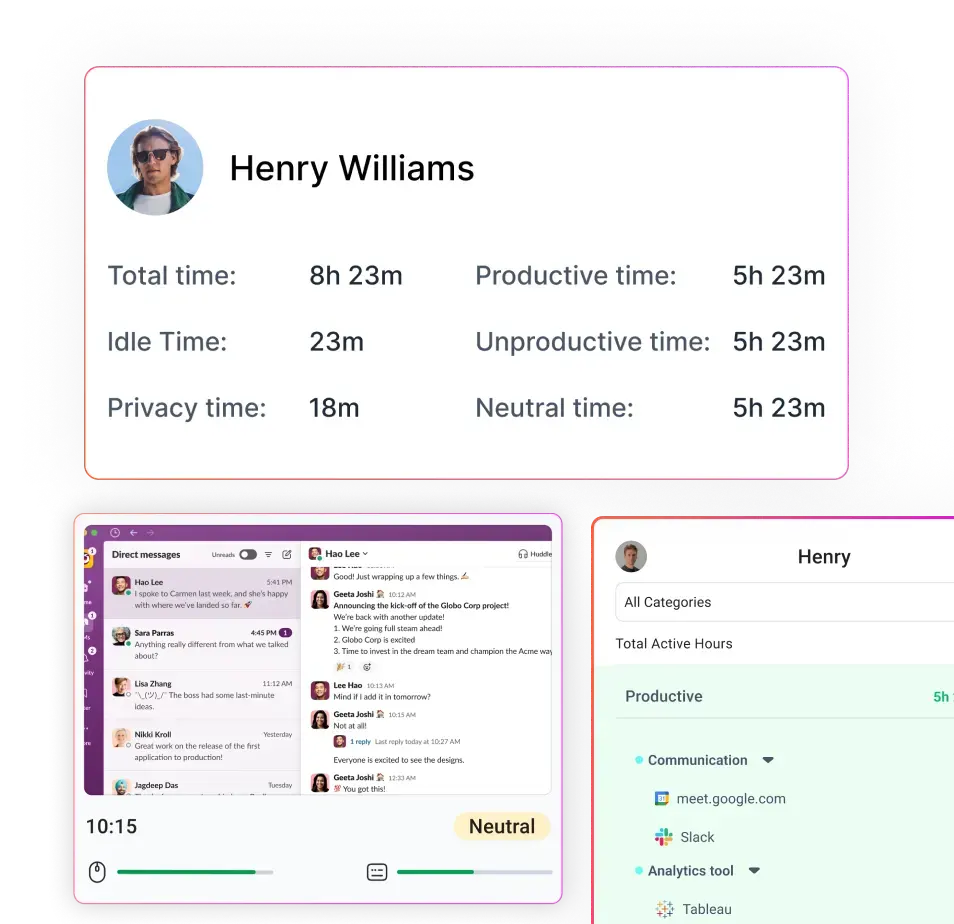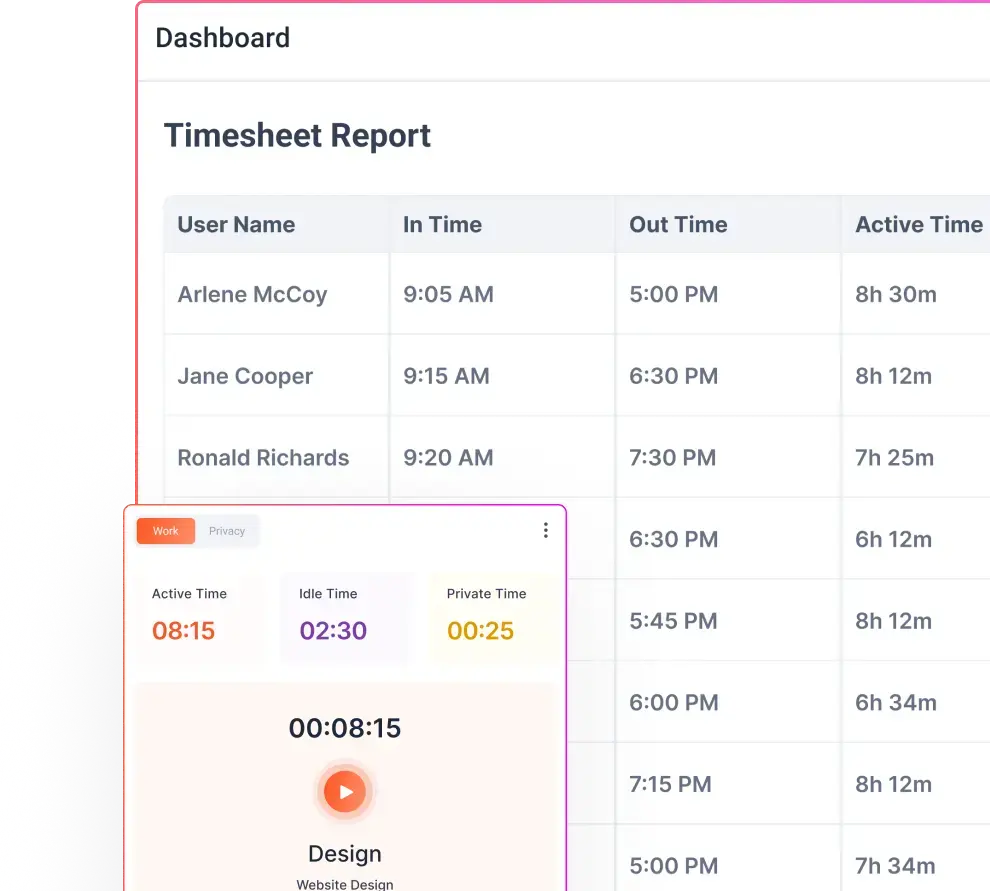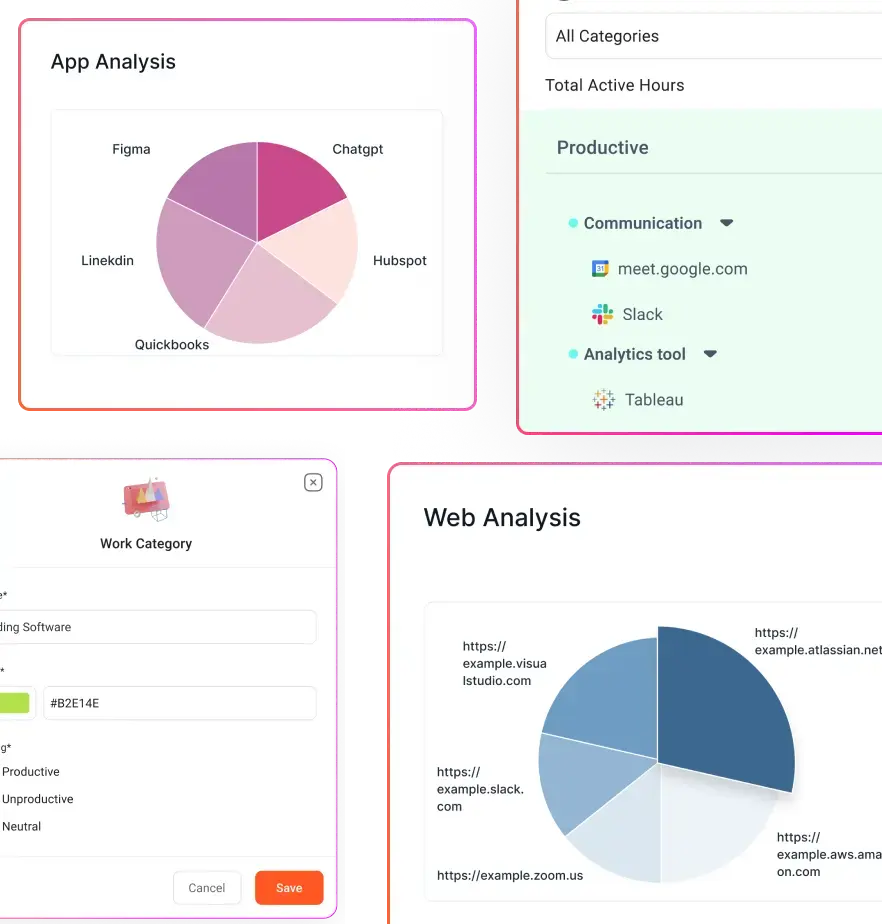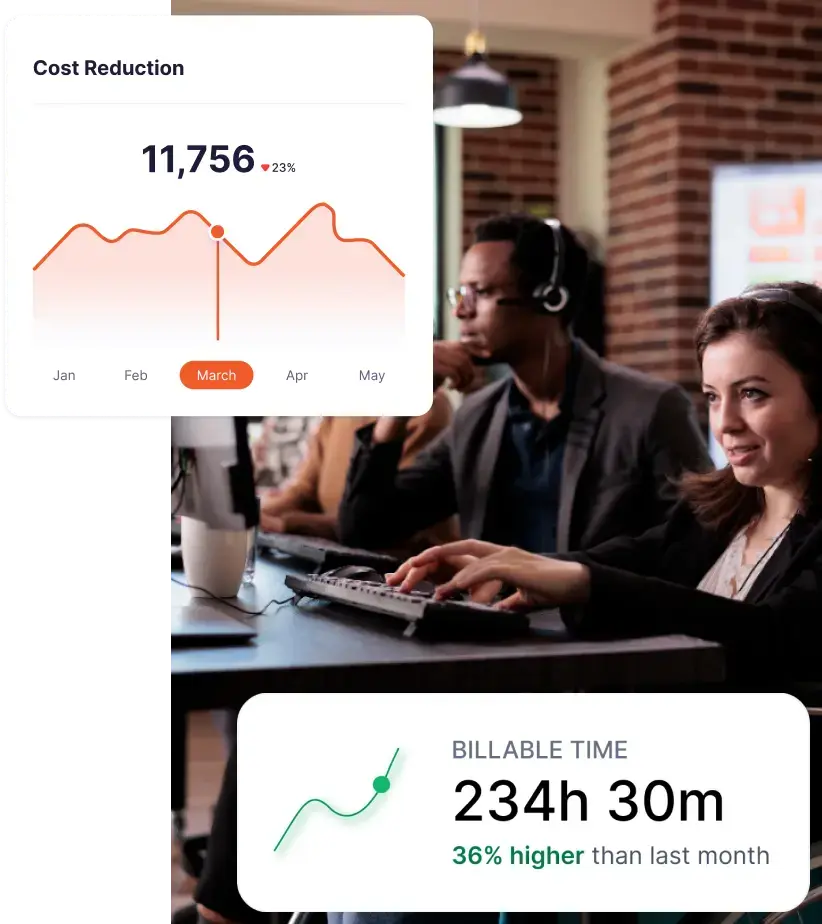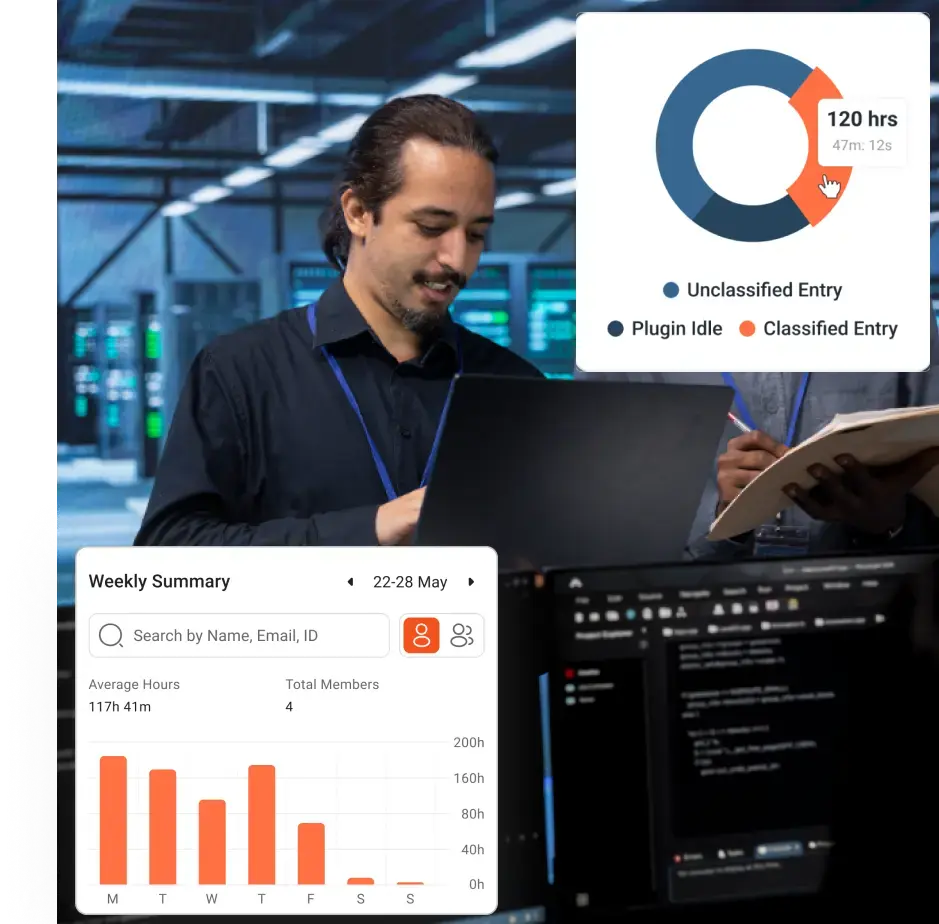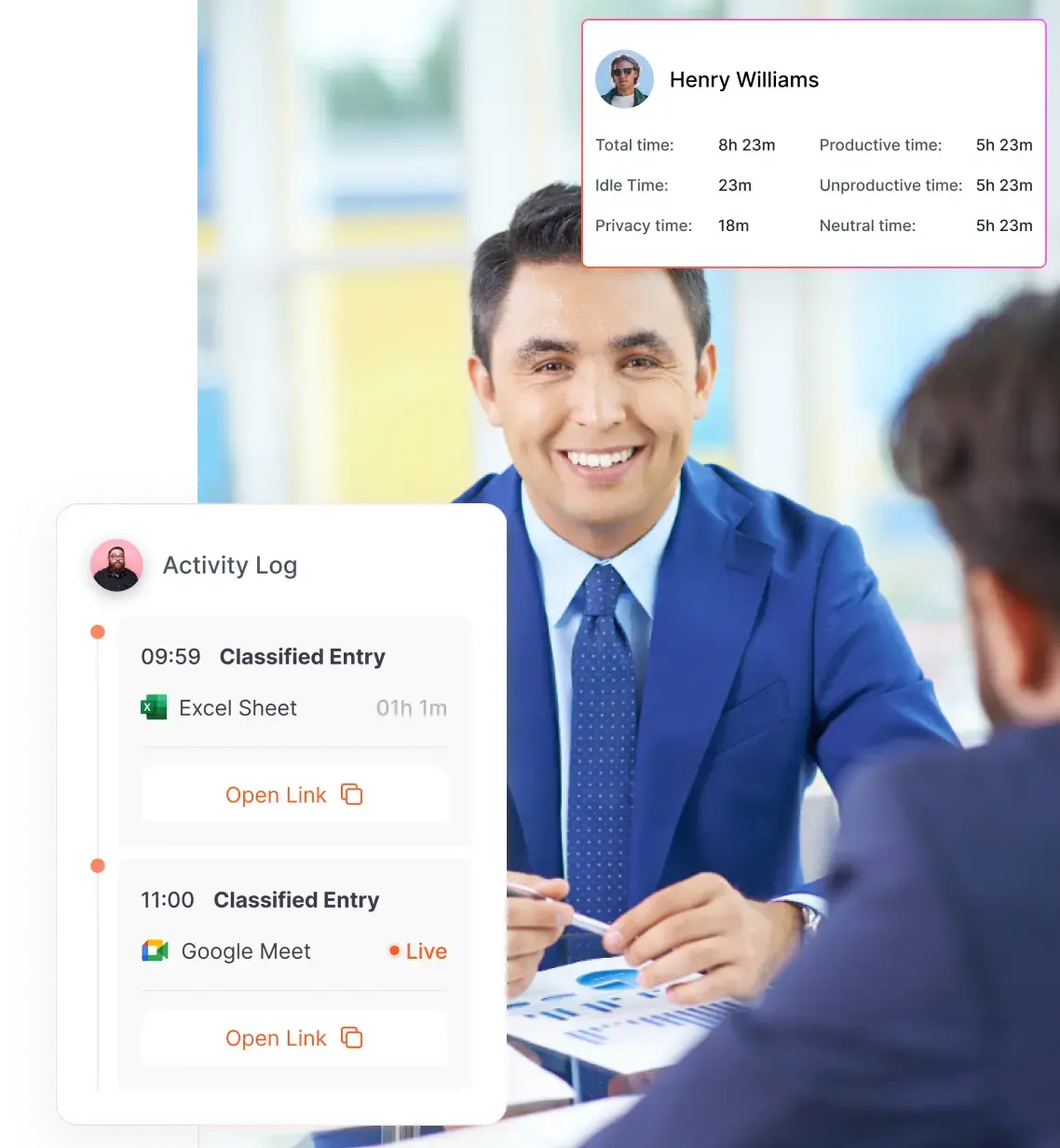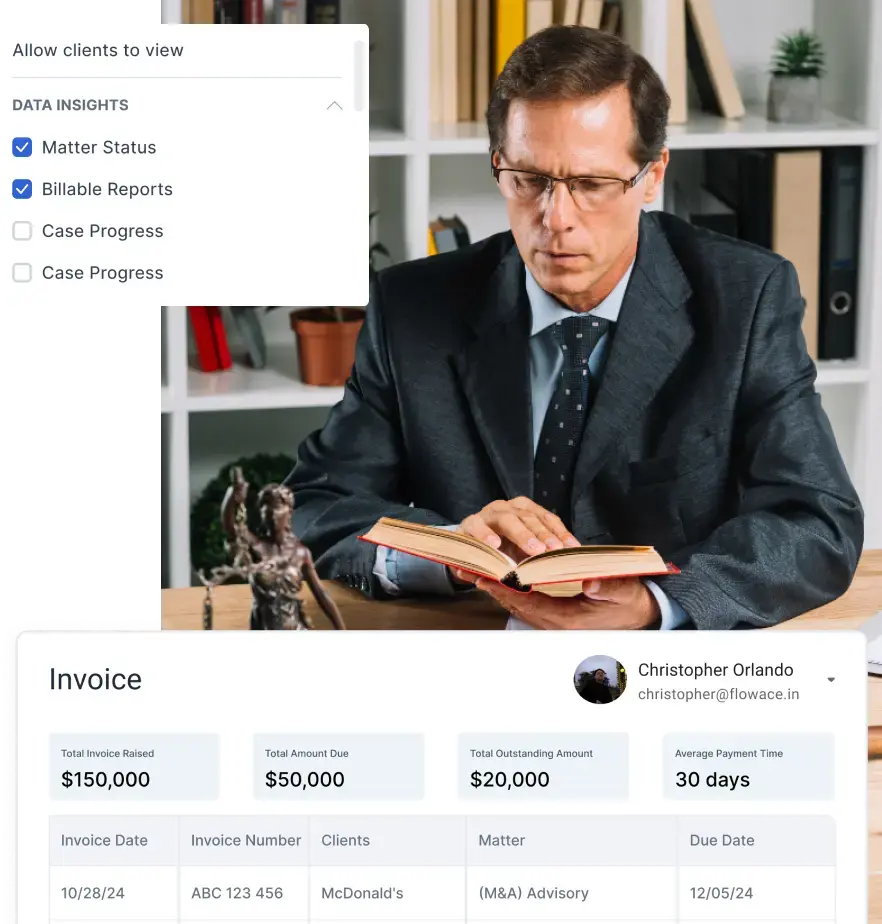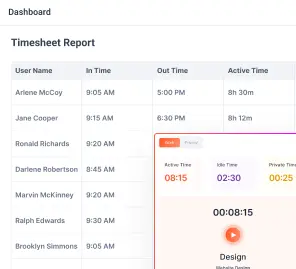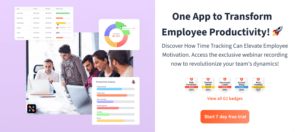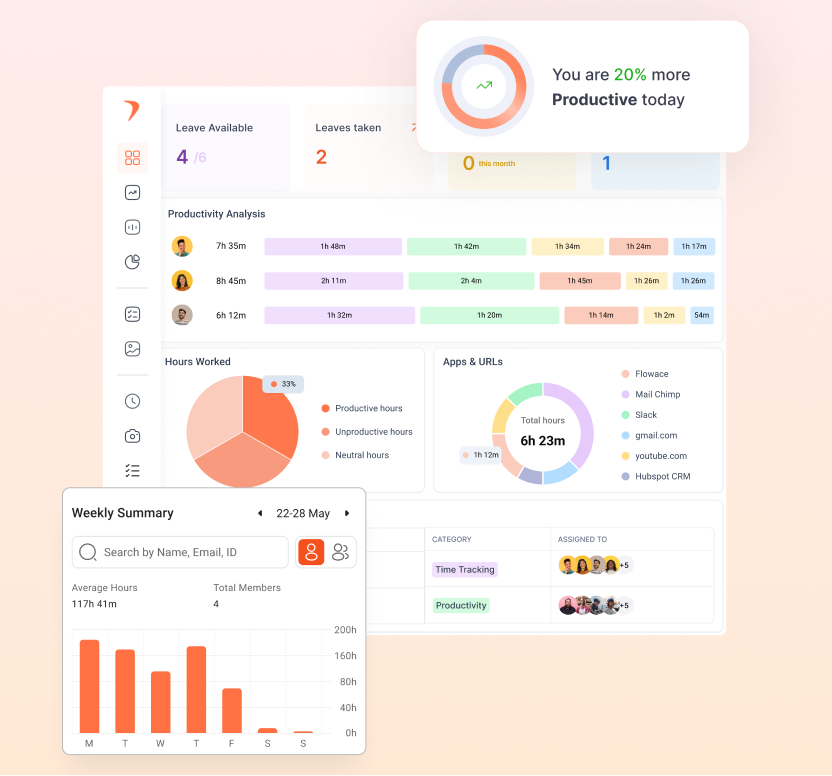Be it a marketer, developer, a BPO agent or consultant, when employees work from home, the managers often worry about their productivity.
Are they really working or getting distracted?
At home, “productivity” gets blurry because you can’t see work the way you used to. This is where work from home monitoring steps in. It gives managers visibility into actual work patterns and helps them understand their employees’ progress and employee well-being.
Key Takeaways
-
Why it matters: With 80% of companies already using monitoring tools, WFH monitoring helps maintain productivity, accountability, and business continuity in remote teams.
-
Essential features: Automatic time tracking, app/website monitoring, productivity dashboards, screenshots, and AI-driven insights to separate focused work from idle time.
-
Implementation: Options include monitoring software, time trackers, project management tools, regular check-ins, and communication oversight—each offering different visibility levels.
-
Privacy & ethics: Success depends on transparency, employee consent, clear boundaries between work and personal activities, and focusing on outcomes—not surveillance.
-
Best practices: Involve employees, use data for coaching and recognition, set clear policies, respect privacy, and follow local laws like GDPR and ECPA.
-
Tool selection: Prioritize automatic tracking, productivity analytics, seamless integrations, employee self-service, strong security, scalability, and user-friendly design.
-
How Flowace helps: AI-powered time tracking, privacy-first productivity insights, easy integrations, remote-ready features, and transparent reports—boosting productivity by 31% at just $2.99/user/month. Start your free trial with Flowace today.
What is Smart Work From Home Monitoring / Remote Employee Monitoring?
Work From Home (WFH) monitoring, also called remote employee monitoring, is about tracking activity, productivity, and compliance when people work outside the office.
In a traditional office, you get productivity cues from simple visibility. You can see who’s at their desk or have a quick check-in. With WFH teams, that line of sight is gone.
Instead, companies use remote employee monitoring software to track WFH employees. These tools run on employees’ devices and automatically track things like you salaried employee work hours, keystrokes, or mouse activity.
Many modern tools operate silently in the background and provide aggregated reports, so managers see overall productivity trends without invading privacy.
Why Businesses Need WFH Monitoring
Remote and hybrid work has become mainstream post the COVID pandemic. But they have brought new challenges as well. Today, around 80% of companies already use work from home monitoring tools to track employee productivity.
Work from home monitoring is essential because:
- Keeps Teams Productive: Monitoring tools track how employees’ time is being spent.
- Balances Workloads: See who’s overloaded and reassign tasks or bill clients fairly.
- Protects Data & Compliance: Flags risky behavior and keeps you GDPR/HIPAA compliant.
- Maintains Service Quality: In BPO industries, WFH monitoring tools track calls and tickets to uphold SLAs and client trust.
- Improves Reviews & Growth: Spot top performers, coach others, and review fairly.
- Prevents Moonlighting & Time Theft: Monitoring ensures employees stay focused on assigned work, reducing risks of dual employment or wasted billable hours.
How to Monitor Employees Working From Home Without Invading Privacy
How can companies actually keep an eye on remote employees? Here are some of the best ways to monitor work-from-home employees:
1. Use Employee Monitoring Software
Tools like Flowace track login times, app usage, and screen activity. These tools run on employees’ computers (and sometimes phones), automatically collecting work data. Many can also take periodic screenshots or even short videos of the screen as proof-of-work
Good monitoring software provides real-time dashboards and reports. With these dashboards, you can track who’s working on what, for how long, and their productivity level. Advanced platforms also use AI to distinguish productive work from idle or unproductive time.
Flowace has already proven its value in transparent monitoring. Our client Hiring Squad was struggling with hidden moonlighting practices that drained productivity and inflated costs. With Flowace, they uncovered time theft and prevented dual employment practices in their organization.
You can read the full story here: How Flowace Prevented Moonlighting.
If you choose this route, communicate with your team about it. Let them know what will be tracked (e.g. work hours, apps, and websites, but not personal files or webcam unless absolutely needed). This transparency helps avoid employee resistance or pushback.
2. Set Up Time-Tracking Tools
If you don’t need full surveillance, a simpler time-tracking tool will suffice. Time-tracking apps let employees log time spent on every task or project. Some tools, like Flowace, even automate timesheets by detecting active work without a manual timer.
Using time trackers allows remote staff to self-report their work durations in a structured way.
For example, a software developer might log 5 hours on coding a new feature and 3 hours on code review in a day. Over time, this builds a record to measure productivity and also to improve project estimates.
3. Use Task & Project Management Software
Another indirect way to monitor remote work is via the tools that teams use to collaborate and manage tasks. Project management software like Asana, Jira, Trello, or ClickUp can act as a form of monitoring.
How? By requiring employees to update task status, add comments, and move items through workflow stages.
For instance, in Jira, a developer might move a ticket from “In Progress” to “Code Review” when done.
Managers can monitor these boards to see the progress of each task. If a task has been “in progress” for an unusually long time, it flags a possible issue needing manager intervention.
This method focuses on output rather than minute-by-minute activity. It’s great for maintaining accountability in results-oriented work.
4. Have Regular Check-Ins
Regular check-in meetings ensure remote employees remain accountable and engaged. Many successful remote teams use daily or weekly stand-ups to discuss:
- what they did yesterday,
- what they plan today, and
- any blockers they face.
If an employee consistently has little to report, it can be addressed constructively.
One-on-one meetings are equally important. A weekly 1:1 between a manager and each team member provides a safe space to discuss progress. Knowing that they will discuss accomplishments at week’s end often motivates employees to stay on track.
But be careful to strike a balance. Too many meetings can backfire. Aim for structured, time-boxed check-ins that support employees rather than policing them.
5. Watch Communication Channels like Teams/Slack
When you work from home, most collaboration happens on tools like Slack, Microsoft Teams, Google Chat, or email. Managers can monitor these channels to gauge engagement and keep information flowing.
This doesn’t mean reading every private chat. Just focus on work channels and overall responsiveness.
If your team has a Slack channel for IT support requests and one technician hasn’t answered any tickets all day, that’s a red flag you might need to follow up on.
Additionally, encourage teams to document their work in shared spaces. If using a platform like Confluence, Notion, or Google Docs, a manager can see contributions. These collaborative footprints double as a monitoring mechanism.
Top Benefits of Ethical WFH Employee Monitoring
When implemented properly, WFH monitoring delivers concrete benefits for both employers and employees. Here are some of the major ways organizations benefit:
- Higher Productivity & Performance: WFH monitoring helps teams stay focused by showing where time is spent and cutting down distractions. Tools like Flowace report up to 30% productivity gains through visibility and habit improvements.
- Accountability and Fair Evaluation: Monitoring creates a data-backed record of each employee’s work, making performance reviews more objective. Top performers get credit, underperformers get support, and “free riders” are exposed.
- Better Workload Management & Burnout Prevention: Tracking shows when someone is overworked or under-utilized. This helps managers rebalance tasks and prevent burnout before it becomes a problem.
- Transparency and Trust with Clients & Stakeholders: Detailed time logs and productivity reports give clients and stakeholders confidence in remote teams. They show that work is happening even without in-person oversight.
- Security and Compliance: Monitoring tools flag suspicious actions like data transfers or unauthorized access. This helps prevent breaches and ensures your remote team stays compliant with regulations like GDPR or HIPAA.
Ethics & Legal Concerns of WFH monitoring: What You Must Know
Despite its benefits, work-from-home monitoring isn’t without controversy. Employees and employers alike have concerns that need to be addressed to implement monitoring in a healthy, ethical way.
Privacy Laws
- You need to adhere to employee monitoring laws.
- In the US, the Electronic Communications Privacy Act (ECPA) limits how employers can monitor digital communications.
- In the EU, the GDPR requires employee consent, purpose limitation, and strict data handling.
- Other regions (India, Canada, Australia) have their own workplace privacy laws.
Consent & Transparency
- Employees must often be informed and, in many jurisdictions, give explicit consent.
- Secret or undisclosed monitoring can be legally challenged.
Data Protection & Security
- Companies must secure collected data against leaks or misuse.
- Monitoring tools that log keystrokes, screenshots, or messages can expose sensitive information if breached.
Retention Policies
- Many laws require clear rules for how long employee data is stored.
- Holding data indefinitely increases legal liability.
Trust vs. Surveillance
- Excessive monitoring can send the message: “We don’t trust you.”
- Many employee monitoring myths erodes morale and psychological safety.
Dignity & Respect
- Monitoring personal apps, webcams, or private messages crosses ethical lines.
- Respecting privacy zones fosters a healthier work culture.
What are the Best Practices for Ethical Work From Home Monitoring?
Follow these employee monitoring best practices to build trust and transparency with your WFH employees:
1. Be Transparent from Day One
Always inform employees upfront about any monitoring, explaining what’s tracked, what isn’t, and why it’s needed (e.g. productivity, security). Provide a clear time and attendance policy document, as transparency builds trust and is legally required in many places.
2. Focus on Outcomes, Not Surveillance
Instead of obsessing over every second, monitor key results like projects completed or client response times. Avoid invasive tactics like webcam feeds or keystroke logging unless necessary, and use tools to track general productivity trends while trusting employees to manage their day.
3. Set Boundaries and Respect Privacy
Define off-limits areas like personal sites or non-work accounts and use features like blurred screenshots or “pause” modes to protect privacy. Limit access to monitoring data to only relevant managers or HR and safeguard all collected data, like other sensitive information.
4. Engage Employees in the Process
Involve your team when setting up monitoring systems and get their input on tools, metrics, and preferences. Let employees view their own data and use it for self-improvement so the process feels collaborative, not controlling.
5. Use Monitoring Data Constructively
Train managers to use data for recognition, coaching, and process improvement. Share anonymized insights with the team to show trends and drive change, making monitoring a tool for growth rather than a threat.
What to Look for in Work From Home Employee Monitoring Software?
If you’ve decided to use a WFH monitoring software, choosing the right tool is important. There are dozens of options on the market, from lightweight trackers to heavy-duty surveillance suites. Here are the key features and functionalities to look for:
- Automatic Time Tracking – Tracks work hours and idle time without manual input.
- App & Website Usage – Shows which apps and sites employees use most.
- Screenshots & Screen Recording – Provides proof-of-work with flexible capture settings.
- Productivity Dashboards – Turns raw data into clear, actionable insights.
- Alerts & Notifications – Flags inactivity, risky behavior, or unusual work patterns.
- Integrations – Connects seamlessly with project, payroll, and HR tools.
- Employee Self-Service – Gives staff control with personal dashboards and private time.
- Security & Compliance – Ensures data safety with encryption and legal compliance.
- Scalability & Performance – Works smoothly for teams of any size across devices.
- Ease of Use & Support – Simple to adopt with strong onboarding and 24/7 help.
Top Tools for WFH Monitoring and What They Offer
Here we highlight a few top-rated WFH monitoring tools, illustrating the range of solutions:
1.. Flowace
- AI-powered time tracking & productivity suite.
- Fully automated: no manual timers needed.
- Tracks: apps, websites, screenshots, attendance, calls.
- AI-driven insights highlight productivity patterns.
- Boosts productivity by 30%+ while reducing costs.
- Ideal for hybrid & remote teams.
- Competitive pricing + strong support.
- Fast-growing global choice for businesses.
2. Time Doctor
- Well-known tool for remote time tracking & monitoring.
- Features: auto time tracking, app/website use, optional screenshots (blurred for privacy), webcam photos, distraction alerts.
- Reports: detailed project time, productivity trends.
- Integrates with Trello, Asana, payroll tools.
- Used by companies like Thrive Market & Firehouse Subs.
- Pricing: from $7/user/month, free version for 1 user.
- Balance of monitoring + productivity, with optional keystroke logging.
3. Hubstaff
- Popular among startups & small businesses.
- Combines time tracking + light project management.
- Features: screenshots, activity levels, GPS/location tracking, scheduling, invoicing.
- Strong for field teams & multiple job sites.
- Customizable screenshot settings (off, blurred, frequency control).
- Reports show project time & productivity %.
- 95,000+ users, rated High Performer on G2.
- Pricing: free plan (1 user), paid plans $7–$10/user/month.
4. Teramind
- Enterprise-grade monitoring & security tool.
- Tracks: live screens, video sessions, emails, chats, clipboard, keystrokes.
- Used in finance, banking, and government for compliance & insider threat detection.
- Features: rule-based alerts, behavior analytics, and block unauthorized actions.
- Deployable on cloud or on-prem.
- Integrates with SIEM & IT security frameworks.
- Pricing: starts $10/user/month+, more expensive but robust.
- Very powerful, but needs ethical, transparent use.
5. ActivTrak
- Productivity analytics platform (not positioned as spyware).
- Tracks app usage, categorizes productive vs. unproductive time.
- Dashboards for individuals, teams, & company-wide insights.
- No keystroke logging or audio/video recording → privacy-friendly.
- Supports goals & benchmarking (e.g., daily focus hours).
- Great for performance discussions & team improvements.
- Free version (up to 3 users), paid plans from $9/user/month.
How Flowace Makes Work From Home Monitoring Seamless?
When it comes to modern WFH monitoring and productivity management, Flowace is a solution that stands out. Flowace is an advanced AI-powered time tracking and employee productivity software designed specifically for remote and hybrid teams. It stands out with:
- Truly Automatic Time Tracking: Flowace runs silently in the background to track apps, websites, and documents without manual timers or timesheets. It detects context switches (e.g., coding to Zoom) to capture every productive minute hands-free.
- Active vs. Idle Time Without Invading Privacy: Flowace distinguishes active vs. idle time using metadata like app usage and website monitoring. It offers productivity clarity while respecting privacy, ensuring transparency and balance.
- AI-Powered Productivity Insights: AI classifies apps/websites as productive, neutral, or distracting and generates role-based productivity scores. Managers get actionable insights, project efficiency reports, and workload trends without manual effort.
- Integration with Work Tools: Flowace integrates with Jira, Asana, Salesforce, payroll, and more to tie tracked time directly to tickets, clients, or HR systems. This ensures seamless accountability within existing workflows.
- Specialized Features (Screenshots, Call Tracking, Attendance): Flowace offers optional screenshots, online attendance, leave tracking, and unique mobile/VoIP call tracking for client-facing teams. These features consolidate multiple tools into one platform.
- Insights for Managers and Employees: Employees see their own activity dashboards to self-manage, while managers get executive views highlighting trends, top performers, and coaching opportunities. This helps both sides improve.
- Business Impact – Productivity & Trust: Flowace user, Digite reports up to 21% boost in productivity and transparency. Its impartial data builds trust, giving credit to hard workers and supporting fair, transparent performance management.
Final Thoughts
Work from home monitoring has become an essential practice in the modern workplace. However, the way monitoring is implemented makes all the difference. The best companies set clear expectations, involve their employees in the conversation, and use monitoring data as a tool for positive change.
And if you’re looking for tools to help implement this strategy, solutions like Flowace offer a path forward. Flowace demonstrates that you can track productivity in a way that’s fair and even welcomed by employees.
Make WFH monitoring fair, simple, and transparent. Book your free demo with Flowace today!
FAQs
- How do you write a productivity report?
Start by defining goals, collect data on employee output and time spent, then summarize findings with insights and recommendations. - How to measure the productivity of an employee?
Measure productivity by comparing output (tasks completed, sales, projects) against time, resources, or goals set. - Should you use employee productivity report templates?
Yes, templates save time, ensure consistency, and help you focus on analyzing results instead of formatting. - What are employee productivity reports used for?
They’re used to track performance, identify trends, optimize workflows, and support data-driven management decisions. - How does a productivity report template benefit my business?
It streamlines reporting, improves accuracy, and makes it easier to monitor progress and boost efficiency. - What types of data can I track with a productivity report template?
You can track hours worked, tasks completed, deadlines met, project progress, and productivity trends. - Is the productivity report template customizable?
Yes, most templates are customizable so you can align them with your specific business goals and metrics. - Can I share the productivity report with my team or stakeholders?
Absolutely, reports can be shared as PDFs, spreadsheets, or dashboards for collaboration and transparency. - How often should I update the productivity report?
Update reports weekly or monthly to keep performance insights accurate, but adjust frequency based on your team’s needs.

